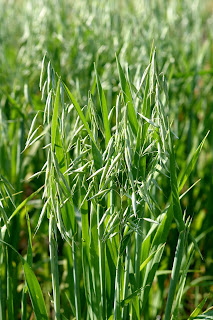The most magnificent flower currently in bloom in the gardens is the Mrs. Perry Slocum Lotus (Nelumbo nucifera). This water garden plant can be seen on the Island Garden though a few more weeks must pass for the Island Garden lotuses and waterlilies to be at peak season.
 Golden Rain Trees (Koelreuteria paniculata) are also in full bloom around the gardens. Their warm, cheery flowers seem most appropriate in this sun drenched season. Many of our trees have suffered this year from being too wet for the third season in a row. This is a tree that demands good drainage. Golden Rain Trees can be invasive in certain areas with glade-like natural areas but has never escaped in the wet clay soils of Powell Gardens.
Golden Rain Trees (Koelreuteria paniculata) are also in full bloom around the gardens. Their warm, cheery flowers seem most appropriate in this sun drenched season. Many of our trees have suffered this year from being too wet for the third season in a row. This is a tree that demands good drainage. Golden Rain Trees can be invasive in certain areas with glade-like natural areas but has never escaped in the wet clay soils of Powell Gardens.
Hardy Mimosa trees (Albizzia julibrissin var. rosea) are also in full bloom at the gardens -- these outside the Conifer Garden outside the north end of the Visitor Center. See my blog from last year on this "you either love them or hate them" tree. This tree is native to cold Korea and is hardier and more refined than the typical species found wild from Iran to Japan.

Buttonbush (Cephalanthus occidentalis) with its marvelous spherical flowers is coming into bloom on the Island Garden. This huge, native shrub can easily be trimmed up into a small tree like we have done on the Island Garden. Its flowers are rich in nectar and visited by many beneficial and pollinating insects.

The large white pom-poms of flower make the Annabelle Hydrangea (Hydrangea arborescens) one the largest flowering of all shrubs. This is actually a selection of Missouri native Wild Hydrangea and was discovered in a garden in Anna, Illinois. Many of our best ornamental shrubs were never specifically hybridized -- just chance seedlings that were discovered by a plantsman with a good eye for promising and unusual garden plants.

The huge flowered and aptly named Bottlebrush Buckeye (Aesculus parviflora) is also a superior midsummer blooming shrub. Bottlebrush Buckeye does become a massive shrub over time -- easily 15 feet or more at maturity with twice the spread! It can be controlled by removing wayward stems and cut back on occasion if so desired. This shrub is almost exclusively native to Alabama, barely venturing into adjacent states in the wild but popular intemperate gardens world-wide!

The showy red color in this shrub is not flowers but fruit. The Shasta Doublefile Viburnums (Viburnum plicatum var. tomentosum) on the Island Garden are loaded with bright red berries this year. Often grown solely for its lacecap flowers that march down either side of its twigs (double file!), the fruit (which ripen black) are actually showy for a much longer period of time than the flowers.
 The Tapestry Hedge in the Perennial Garden just got a haircut to keep it a maximum height of 8 feet. You can see that the Perennial Garden is awash in floral color as Booms and Blooms looms for a daylily extravaganza next week.
The Tapestry Hedge in the Perennial Garden just got a haircut to keep it a maximum height of 8 feet. You can see that the Perennial Garden is awash in floral color as Booms and Blooms looms for a daylily extravaganza next week.









































